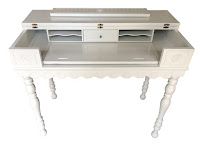 |
| Armchair Before |
love. The fabric was stained and worn, with evidence of a cat who likely used the back to sharpen her nails. Needless to say this chair had seen better days.
 |
| Armchair After |
The far right support board was cracked and had come apart from the arm. This board needed to be reattached with glue and a single screw. The top curved board was cracked in the center; the inner right board had broken off at the top. Repairs included making a new dowel and reattaching the inner support board and gluing, then screwing the outer side board back in place to make it structurally sound. *(See photo below to see where the chair was broken and repaired).
Once the repairs were made and the structure strong again, the legs were stripped, sanded and restrained then protected with polyurethane. After Jim had worked his magic, it was my turn to tackle the exterior upholstery.
This chair had zig-zag springs which were in great condition, so they didn’t need to be tightened or replaced. The first step was to cover the springs with burlap, which was stapled to the top edge of the seat. Burlap keeps the springs secure, while providing a good foundation for the layers that follow. After the burlap was secure, I added a 1” thick section of high density foam which covered the entirespring/burlap seating area. A few staples held the foam in place.
Next, raw cotton was liberally layered on top of the foam, creating a nice “crown” for the chair’s seat. The raw cotton can be purchased per yard, or per a 10 yard bulk, which is the preferred method as it is less costly per yard. The final layer was a 1/4” foam, which was also stapled to keep it secure. I always give it the “sit” test, which is when I sit on the chair and test its softness and support. You shouldn’t feel the springs when sitting on a chair. If you feel springs, there’s not enough padding. I was satisfied with the thickness of the padding, so I cut the fabric for the seat and made the “V” cuts carefully around the arms and legs for a perfect fit.
This was my first fluted back chair, so I researched how to create the “flutes,” or “channels.” However, before I could get to the fluted portion of the chair, I had to pad the arms and create new fabric panels for the sides. Using raw cotton and foam, I made sure both arms would be soft as well as supportive enough for the new fabric. I chose not to use the old fabric as templates. Instead, I made my own templates from muslin. This allowed me to customize the arms and create a “partial sewn” arm instead of just folding fabric and stapling in place. The fit was perfect.
I can’t say enough about making an accurate template for upholstery work! It is an essential part of getting that perfect fit. And with plenty of muslin at my disposal, I was able to create accurately measured templates for each arm, then sew them together to test them before I cut the fabric. Templates can save a lot of time and fabric and ensure accuracy and a proper fit. Measuring is also essential. The more accurate the measurements, the better turnout.
For the flutes, or channels, I used the original fabric as templates. I took apart the original fluting, separating them into individual units. (I like to iron the old fabric. This flattening makes it easier when cutting the new fabric).
Once the flattened templates are laid on the new fabric, it’s necessary to allow a few inches to the top and bottom lengths, so there is enough material to pull underneath the seat and over the chair's frame. The individual units are then sewn together. Once they are attached, they are sewn to the backing fabric on lines you have created by measuring the original fabric. The lines on the backing fabric must be narrower than the flutes to create enough space for the fiber fill or cotton. My channels measured 5-1/2”, so I drew lines that measured 4-1/2”.
Prior to attaching the flutes, I made marks on the top rail of the chair to line up the fabric to keep it centered. The last fabric panel I attached was the back. After it stapled to the frame, I created the double cording, or piping. This is used to cover the staples and add a customized look to the chair.
The fabric I used for this project was burgundy, with a diamond motif, that I had used last year to reupholster a bench. My customer saw this fabric on the blog and loved it, so she wanted it for her chair. Luckily I was able to get the same fabric! It’s one of my personal favorites. You can view that bench by clicking on this link: http://finalefurniture.blogspot.com/2021/11/antique-bench-trash-to-treasure.html
This chair was a true challenge, but with each project, I learn and advance my upholstery and sewing skills, which I truly enjoy.
 |
| View of repairs |

































